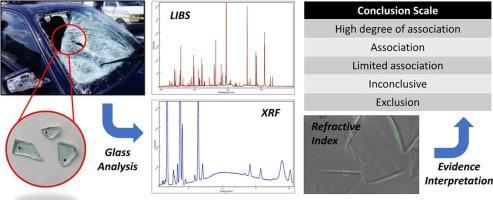Forensic Chemistry ( IF 2.6 ) Pub Date : 2021-01-12 , DOI: 10.1016/j.forc.2021.100307 Ruthmara Corzo 1, 2 , Tricia Hoffman 1 , Troy Ernst 3 , Tatiana Trejos 4 , Ted Berman 5 , Sally Coulson 6 , Peter Weis 7 , Aleksandra Stryjnik 8 , Hendrik Dorn 8 , Edward Chip Pollock 9 , Michael Scott Workman 10 , Patrick Jones 11 , Brendan Nytes 12 , Thomas Scholz 13 , Huifang Xie 14 , Katherine Igowsky 15 , Randall Nelson 16 , Kris Gates 17 , Jhanis Gonzalez 18 , Lisa-Mareen Voss 7 , Jose Almirall 1

|
Seventeen laboratories participated in three interlaboratory exercises to assess the performance of refractive index, micro X-ray Fluorescence Spectroscopy (µXRF), and Laser Induced Breakdown Spectroscopy (LIBS) data for the forensic comparison of glass samples. Glass fragments from automotive windshields were distributed to the participating labs as blind samples and participants were asked to compare the glass samples (known vs. questioned) and report their findings as they would in casework. For samples that originated from the same source, the overall correct association rate was greater than 92% for each of the three techniques (refractive index, µXRF, and LIBS). For samples that originated from different vehicles, an overall correct exclusion rate of 82%, 96%, and 87% was observed for refractive index, µXRF, and LIBS, respectively. Special attention was given to the reporting language used by practitioners as well as the use of verbal scales and/or databases to assign a significance to the evidence. Wide variations in the reported conclusions exist between different laboratories, demonstrating a need for the standardization of the reporting language used by practitioners. Moreover, few labs used a verbal scale and/or a database to provide a weight to the evidence. It is recommended that forensic practitioners strive to incorporate the use of a verbal scale and/or a background database, if available, to provide a measure of significance to glass forensic evidence (i.e., the strength of an association or exclusion).
中文翻译:

使用折射率测量和元素组成评估法医玻璃证据解释的实验室间研究
17 个实验室参加了三个实验室间练习,以评估用于玻璃样品法医比较的折射率、微 X 射线荧光光谱 (µXRF) 和激光诱导击穿光谱 (LIBS) 数据的性能。来自汽车挡风玻璃的玻璃碎片作为盲样品分发给参与的实验室,参与者被要求比较玻璃样品(已知与质疑)并报告他们的发现,就像他们在案例工作中一样。对于来自同一来源的样品,三种技术(折射率、µXRF 和 LIBS)中每一种的总体正确关联率均大于 92%。对于来自不同车辆的样本,总体正确排除折射率、µXRF 和 LIBS 的比率分别为 82%、96% 和 87%。特别注意从业者使用的报告语言以及使用口头量表和/或数据库来确定证据的重要性。不同实验室之间报告的结论存在很大差异,这表明需要对从业人员使用的报告语言进行标准化。此外,很少有实验室使用口头量表和/或数据库来为证据提供权重。建议法医从业者努力结合使用口头量表和/或背景数据库(如果有的话),以提供对玻璃法医证据的重要性度量(即关联或排除的强度)。











































 京公网安备 11010802027423号
京公网安备 11010802027423号